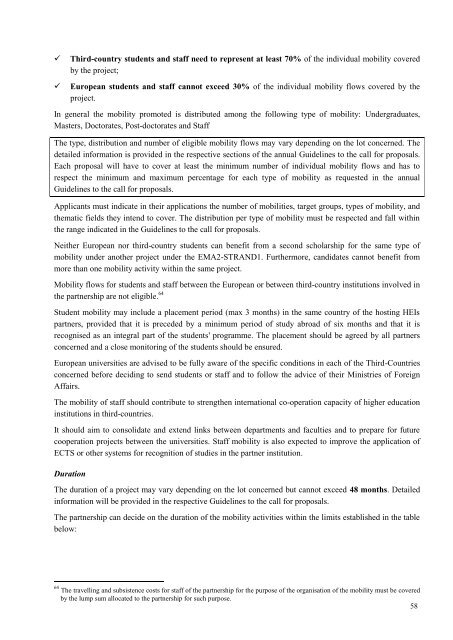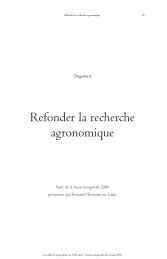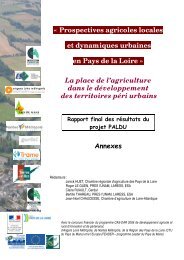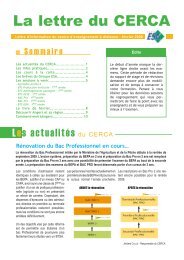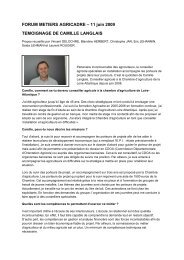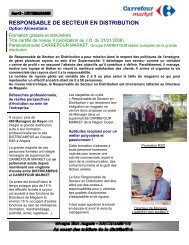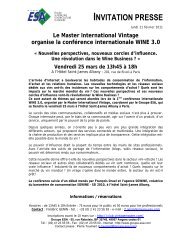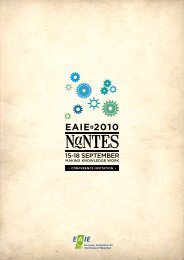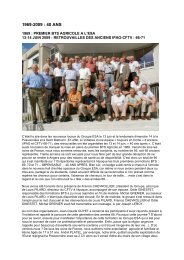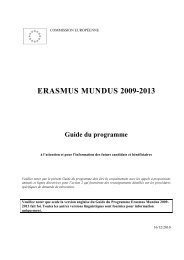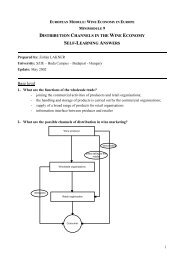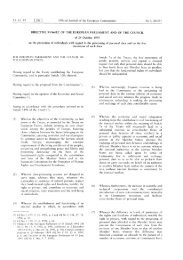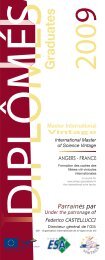ERASMUS Mundus Program Guide - EACEA - Europa
ERASMUS Mundus Program Guide - EACEA - Europa
ERASMUS Mundus Program Guide - EACEA - Europa
Create successful ePaper yourself
Turn your PDF publications into a flip-book with our unique Google optimized e-Paper software.
Third-country students and staff need to represent at least 70% of the individual mobility covered<br />
by the project;<br />
European students and staff cannot exceed 30% of the individual mobility flows covered by the<br />
project.<br />
In general the mobility promoted is distributed among the following type of mobility: Undergraduates,<br />
Masters, Doctorates, Post-doctorates and Staff<br />
The type, distribution and number of eligible mobility flows may vary depending on the lot concerned. The<br />
detailed information is provided in the respective sections of the annual <strong>Guide</strong>lines to the call for proposals.<br />
Each proposal will have to cover at least the minimum number of individual mobility flows and has to<br />
respect the minimum and maximum percentage for each type of mobility as requested in the annual<br />
<strong>Guide</strong>lines to the call for proposals.<br />
Applicants must indicate in their applications the number of mobilities, target groups, types of mobility, and<br />
thematic fields they intend to cover. The distribution per type of mobility must be respected and fall within<br />
the range indicated in the <strong>Guide</strong>lines to the call for proposals.<br />
Neither European nor third-country students can benefit from a second scholarship for the same type of<br />
mobility under another project under the EMA2-STRAND1. Furthermore, candidates cannot benefit from<br />
more than one mobility activity within the same project.<br />
Mobility flows for students and staff between the European or between third-country institutions involved in<br />
the partnership are not eligible. 64<br />
Student mobility may include a placement period (max 3 months) in the same country of the hosting HEIs<br />
partners, provided that it is preceded by a minimum period of study abroad of six months and that it is<br />
recognised as an integral part of the students' programme. The placement should be agreed by all partners<br />
concerned and a close monitoring of the students should be ensured.<br />
European universities are advised to be fully aware of the specific conditions in each of the Third-Countries<br />
concerned before deciding to send students or staff and to follow the advice of their Ministries of Foreign<br />
Affairs.<br />
The mobility of staff should contribute to strengthen international co-operation capacity of higher education<br />
institutions in third-countries.<br />
It should aim to consolidate and extend links between departments and faculties and to prepare for future<br />
cooperation projects between the universities. Staff mobility is also expected to improve the application of<br />
ECTS or other systems for recognition of studies in the partner institution.<br />
Duration<br />
The duration of a project may vary depending on the lot concerned but cannot exceed 48 months. Detailed<br />
information will be provided in the respective <strong>Guide</strong>lines to the call for proposals.<br />
The partnership can decide on the duration of the mobility activities within the limits established in the table<br />
below:<br />
64 The travelling and subsistence costs for staff of the partnership for the purpose of the organisation of the mobility must be covered<br />
by the lump sum allocated to the partnership for such purpose.<br />
58


